Unit 3 Gricean Pragmatics Implicature格莱斯语用学会话含义
- 格式:pptx
- 大小:10.22 MB
- 文档页数:29
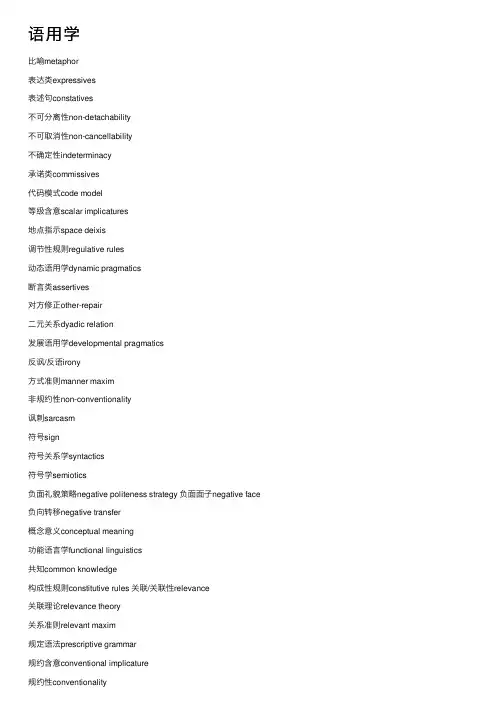
语⽤学⽐喻metaphor表达类expressives表述句constatives不可分离性non-detachability不可取消性non-cancellability不确定性indeterminacy承诺类commissives代码模式code model等级含意scalar implicatures地点指⽰space deixis调节性规则regulative rules动态语⽤学dynamic pragmatics断⾔类assertives对⽅修正other-repair⼆元关系dyadic relation发展语⽤学developmental pragmatics反讽/反语irony⽅式准则manner maxim⾮规约性non-conventionality讽刺sarcasm符号sign符号关系学syntactics符号学semiotics负⾯礼貌策略negative politeness strategy 负⾯⾯⼦negative face 负向转移negative transfer概念意义conceptual meaning功能语⾔学functional linguistics共知common knowledge构成性规则constitutive rules 关联/关联性relevance关联理论relevance theory关系准则relevant maxim规定语法prescriptive grammar规约含意conventional implicature规约性conventionality规则rule含混ambivalence含意implicature合适条件felicity condition后指⽤法cataphoric use互补性complementarity互动语⽤学interactive pragmatics互明mutual manifestness互知mutual knowledge互指co-referential话轮turn-taking话语utterance话语分析discourse analysis话语意义utterance meaning话语指⽰discourse deixis缓叙meiosis会话分析conversation analysis会话含意conversational implicature 会话结构conversational structure会话修正conversational repair会话原则conversational principle或然性probability记号symbol间接⾔语⾏为indirect speech act交际⽬的communicative goal/purpose 交际能⼒communicative competence 交际意图communicative intention交际⽤意communicative force交际原则communicative principle近指proximal terms经济原则principle of economy旧信息old information句法学syntax句⼦意义sentence meaning可接收性acceptability可取消性cancellability可推导性calculability可⾏性feasibility客观环境physical situation夸张hyperbole跨⽂化语⽤学cross-cultural pragmatics离格deviance礼貌politeness礼貌策略politeness strategy礼貌原则politeness principle连贯coherence两可性ambiguity量准则quantity maxim临床语⽤学clinical pragmatics笼统性generality论⾔有所为How to do things with words逻辑语义学logical semantics蒙塔古语法Montague grammar⾯⼦face1明⽰-推理过程ostensive-inferential process 明说explicature 命题⾏为propositional act模糊限制语hedges模糊性fuzziness内嵌施为句embedded performatives恰当性appropriateness前提presupposition前提触发语presupposition triggers前指⽤法anaphoric use⼈称指⽰person deixis⼈类⽂化⽅法论ethnomethodology认知效果cognitive effect认知语⽤学cognitive pragmatics认知语⽤学cognitive pragmatics认知原则cognitive principle弱陈meiosis三元关系triadic relation社会语⽤学societal pragmatics社交语⽤学social pragmatics社交-语⽤学socio-pragmatics社交指⽰social deixis施为动词performative verb施为假设performative hypothesis施为句performatives施为⽤意illocutionary force时间指⽰time deixis实⽤主义pragmatism顺应理论adaptation theory说话⼈意义speaker meaning 随意⾔谈loose talk 特殊含意particularized conversational implicature 同义反复句tautology投射规则projection rule推理努⼒processing effort威胁⾯⼦的⾏为face threatening acts委婉语understatement未知信息unknown information衔接机制cohesive device显性施为句explicit performatives新格赖斯会话含意理论neo-Gricean theory of conversational implicature新格赖斯语⽤学neo-Gricean pragmatics新信息new information信息意图informative intention信息照应information bridging形式语⽤学formal pragmatics修辞学rhetoric宣告类declarations选择限制selectional restriction⾔语交际verbal communication⾔语情景speech situation⾔语⾏为speech act⾔语⾏为理论speech act theory⼀般会话含意generalized conversational implicature 已知信息known information以⾔成事perlocutionary act以⾔⾏事illocutionary act以⾔⾏事⽬的/施为⽬的illocutionary goal以⾔指事locutionary act意思sense意图intention意向性intentionality隐含结论implicated conclusion隐含前提implicated premise隐性施为句implicit performatives隐喻metaphor语法性grammaticality语际语interlanguage语际语⽤学interlanguage pragmatics语境暗含contextual implication语境化contextualization语境假设contextual assumptions语境效果contextual effect语境意义contextual meaning语境因素contextual factor语句sentence语句意义sentence meaning语⾔学转向linguistic turn语⾔语境linguistic context语⾔语⽤学linguistic pragmatics语义前提semantic presupposition语义学semantics语⽤代码pragmatic code语⽤含糊pragmatic vagueness语⽤含意pragmatic force语⽤类属pragmatic category语⽤能⼒pragmatic competence语⽤歧义pragmatic ambiguity语⽤迁移pragmatic transfer2语⽤前提pragmatic presupposition语⽤推理pragmatic inference语⽤⾏为pragmatic act语⽤学pragmatics语⽤移情pragmatic empathy语⽤语⾔学pragmalinguistics语⽤原则pragmatic principle寓意⾔谈metaphorical talk元交际⾏为metacommunicative behaviour 元指⽤法meta-phoric use原意或刻意⾔谈literal talk原则principle远指distal terms约略性approximation蕴涵entailment哲学语⽤学philosophical pragmatics正⾯礼貌positive politeness正⾯⾯⼦positive face正向转移positive transfer指称reference指令类directives指⽰词语deictic expressions指⽰语deixis, indexicals质准则quality maxim中介语/语际语interlanguage主题topic字⾯⽤意literal force⾃我修正self-repairadaptability顺应性(1.2.2)affective mutuality情感共享(4.5.3)agreement maxim⼀致准则(2.2.1)anaphora前照应(6.1.1)anaphoric use前照应⽤法(6.1.1)approbation maxim赞誉准则(3.2.4)appropriate conditions合适条件(3.2.4)assertives断⾔类(以⾔⾏事)(3.2.3)behabitives表态类以⾔⾏事(3.2.1)calculability(含意的)可推导性(4.4.2)calendric time units历法时间单位(6.1.3)cancellability(含意的)可取消性(4.4.2)change-of-state verbs状态变化动词(6.2.4)code model代码(交际)模式(2.1.1)cognitive environment认知环境(5.2)cognitive mutuality认知共享(4.5.3)cognitive pragmatics认知语⽤学(1.5)collaborative performatives协作性施为句(3.2.1) commissives承诺类(以⾔⾏事)(3.2.1) common knowledge共知(5.2)communicative competence交际能⼒(7.1)communicative intention交际意图(1.3.2)communicative language ability语⾔交际能⼒(7.1)constatives表述句(3.2.1)context语境(1.1)context of situation情景语境(5)contextual assumptions语境假设(1.5.4)contextual correlates语境相关因素(5.1.1) contextual effects语境效果(1.5.4)contextual features语境特征(5.1.1)contextual implication语境暗含(1.5.4)contextual meaning语境意义(1.2.3)contrastive markers对⽐性标记语(6.4.1) contrastive pragmatics对⽐语⽤研究(1.5.2)conventional implicature常规含意(4.4.1)conventionalization规约化(1.3.2)conversation analysis/CA会话分析(1.2.2)conversational implicature会话含意(4.4.1)conversation structure会话结构(1.2.2)cooperative principle/CP合作原则(2.1.2)co-text上下⽂(5.1.1)cross-cultural communication跨⽂化交际(8.1)cross-cultural pragmatics跨⽂化语⽤学(1.2.2)culture-loaded words富含⽂化内涵词语(8.2.1)declarations宣告类(以⾔⾏事)(3.2.3)decoding解码(2.1.1)defeasibility(含意的)可废除性(6.2.5)deictic center指⽰中⼼(6.1.1)deictic expression指⽰语(1.1)deictic use指⽰⽤法(6.1.1)deictics指⽰语(1.1)deixis指⽰语(1.1)developmental pragmatics发展语⽤学(1.6)directives指令类(以⾔⾏事)(3.2.3)disambiguation消除歧义(5.4)discourse deixis话语指⽰(6.1.1)discourse markers话语标记语(1.2.4)discourse meaning语篇意义(1.2.4)discourse operator话语操作语(6.4)3discourse particles话语⼩品词(6.4)dynamic pragmatics动态语⽤学(4.6)elaborative markers阐发性标记语emphathetic deixis移情指⽰encoding编码encyclopaedic information百科信息entailment蕴涵equivalent effect等值效果/等效essential condition(实施⾔语⾏为的)基本条件ethnography(of communication)(交际中的)⼈类⽂化学exercitives⾏使类(以⾔⾏事)explicature明说explicit performatives显性施为句expositives阐述类(以⾔⾏事)expressives表情类(以⾔⾏事)extended speech act theory扩充的⾔语⾏为理论face⾯⼦face theory⾯⼦理论face threatening acts/FTA威胁⾯⼦的⾏为factive verbs叙实性动词felicity conditions合适条件filler填充语gambits话语策略语general pragmaticsgeneralized implicature⼀般会话含意generosity maxim慷慨准则gestural use⼿势⽤法grammatical competence语法能⼒group performatives群体性施为句guiding culture主⽂化hearing meaning听话⼈意义hedge模糊限制语illocutionary competence施为能⼒illocutionary force施为⽤意implicated conclusion暗含结论implicated premise暗含前提implicative verbs含蓄性动词implicature暗含/含意implicit performatives隐性施为句indeterminacy(含意的)不确定性indirect speech act间接⾔语⾏为inference推理inferential markers推导性标记语语⽤学重要术语英汉对照解释1、Adjacency pair: 相邻对 A sequence of two utterances by different speakers in conversation. The second is a response to the first, e.g., question-answer.2、Background entailment: 背景蕴涵Any logical consequence of an utterance.3、Commissive: 承诺句A speech act in which the speaker commits himself or herself to some future action, e.g. a promise.4、Content conditions: 内容条件In order to count as a particular type of speech act, an utterance must contain certain features, e.g. a promise must be about a future event.5、Conversational implicature: 会话含义An additional unstated meaning that has to be assumed in order to maintain cooperative principle, e.g.if someone says “The President is a mouse”, something that is literally false, the hearer must assume the speaker means to convey more than is being said.6、Declaration: 宣告句A speech act that brings about a change by beinguttered, e.g. a judge pronouncing a sentence.-7、Deixis: 指⽰“Pointing” via language, using a deictic expression,e.g. “this”, “here”.8、Directive: 指令句A speech act used to get someone else to do something,e.g. an order.9、Discourse analysis: 话语分析The study of language use with referenceto the social and psychological factors that influence communication.10、Dispreferred: 不期待The structurally unexpected next utterance as aresponse, e.g. an invitation is normally followed by an acceptance, so a refusal is dispreferred.411、Entailment: 蕴涵Something that logically follows from what is asserted.12、Expressive: 表达句A speech act in which the speaker expresses feelings or attitudes, e.g. an apology.13、Face: ⾯⼦A person’s public self-image.14、Felicity conditions: 恰当条件 The appropriate conditions for a speech act to be recognized as intended.15、Generalized conversational implicature: ⼀般性会话含义An additional unstated meaning that does not depend on special or local knowledge. 16、Honorific: 敬语 Expression which marks that the addressee is of higher status.17、Illocutionary force: ⾔外之⼒The communicative force of an utterance.18、Insertion sequence: 插⼊系列 A two part sequence that comes between the first and second parts of another sequence in conversation.19、Manner Maxim: ⽅式准则One of the maxims, in which the speaker is to be clear, brief, and orderly.20、Maxim: 准则One of the four sub-principles of the cooperative principle.21、Particularized conversational implicature: 特殊会话含义An additional unstated meaning that depends on special or local knowledge.22、Performative verb: ⾏事动词A verb that explicitly names the speech act, e.g. the verb “promise” in the utterance “I promise to be there”.23、Perlocutionary act: 以⾔成事 The effect of an utterance used to perform a speech act.24、Person deixis: ⼈称指⽰Forms used to point ot people, e.g. “me”, “you”.25、Pragmatics: 语⽤学 The study of speaker meaning as distinct from word or sentence meaning. 26、Preferred: 期待的The structurally expected next utterance used ina response.27、Preparatory conditions: 准备条件Specific requirements prior to an utterance in order for it to cont as a particular speech act.28、Presupposition: 前提Something the speaker assumes to be the case.29、Projection problem: 映射问题The problem of the presupposition of a simple structure not surviving when part of a more complex structure.30、Quality maxim: 质量准则One of the maxims, in which the speaker has to be truthful.31、Quantity maxim: 数量准则One of the maxims, in which the speaker has to be neither more nor less informative than is necessary.32、Reference: 照应An act by which a speaker uses a word, or words, to enable a listener to identify someone or something.33、R elation maxim: 相关准则One of the maxims, in which the speaker has to be relevant.34、Representative: 阐述句A speech act in which the speaker states what is believed or known, e.g. an assertion.35、Sincerity conditions: 诚意条件Requirements on the genuine intentions of a speaker in order for an utterance to count asa particular speech act.36、Social deixis: 社会指⽰Forms used to indicate relative social status.37、Speech act: ⾔语⾏为An action performed by the use of an utterance to communicate.38、Textual function: 篇章功能The use of language in the creation of well-formed text.39、Turn-taking: 轮换The change of speaker during conversation5。
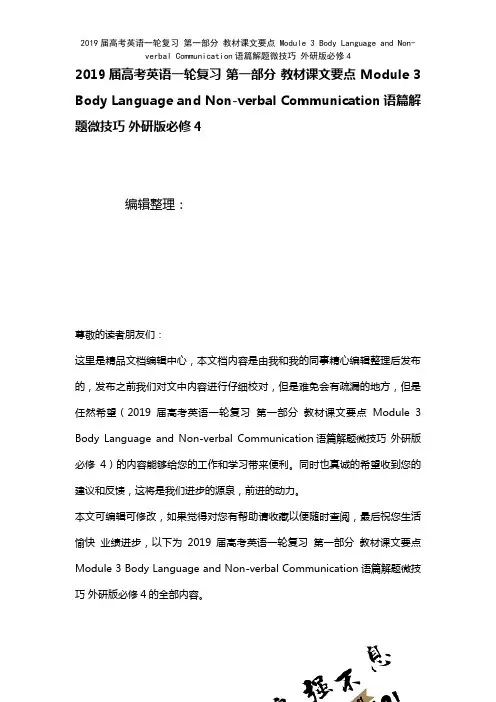
2019届高考英语一轮复习第一部分教材课文要点 Module 3 Body Language and Non-verbal Communication语篇解题微技巧外研版必修42019届高考英语一轮复习第一部分教材课文要点 Module 3 Body Language and Non-verbal Communication语篇解题微技巧外研版必修4编辑整理:尊敬的读者朋友们:这里是精品文档编辑中心,本文档内容是由我和我的同事精心编辑整理后发布的,发布之前我们对文中内容进行仔细校对,但是难免会有疏漏的地方,但是任然希望(2019届高考英语一轮复习第一部分教材课文要点Module 3 Body Language and Non-verbal Communication语篇解题微技巧外研版必修4)的内容能够给您的工作和学习带来便利。
同时也真诚的希望收到您的建议和反馈,这将是我们进步的源泉,前进的动力。
本文可编辑可修改,如果觉得对您有帮助请收藏以便随时查阅,最后祝您生活愉快业绩进步,以下为2019届高考英语一轮复习第一部分教材课文要点Module 3 Body Language and Non-verbal Communication语篇解题微技巧外研版必修4的全部内容。
1 / 71Module 3 Body Language andNon-verbal Communication推理判断题之写作目的题(阅读理解)方法指导推断写作目的的题目题干中常有purpose,或后面需接表示目的的动词不定式等。
推断作者写该篇文章的目的,有两大思路,解题时要综合考虑:1.主旨推断法写作意图与文章主旨密切相关,因此,解答这类题跟解答主旨大意题和选择文章标题一样,用略读法,即重点关注文章首尾段和各段的首尾句,找到主题句,抓住文章主旨,然后由主旨来推断作者的写作目的。
议论文、新闻报道、说明文等,其主题句多在文首.2.文体推断法作者的写作目的与文体密切相关。
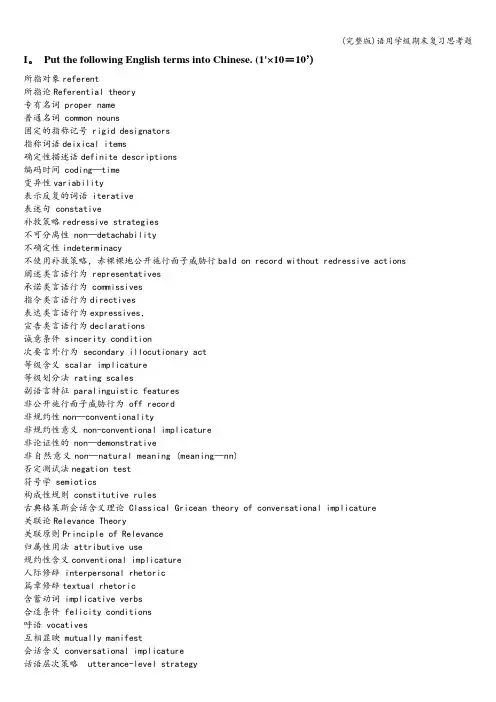
I。
Put the following English terms into Chinese. (1'×10=10’)所指对象referent所指论Referential theory专有名词 proper name普通名词 common nouns固定的指称记号 rigid designators指称词语deixical items确定性描述语definite descriptions编码时间 coding—time变异性variability表示反复的词语 iterative表述句 constative补救策略redressive strategies不可分离性 non—detachability不确定性indeterminacy不使用补救策略,赤裸裸地公开施行面子威胁行bald on record without redressive actions 阐述类言语行为 representatives承诺类言语行为 commissives指令类言语行为directives表达类言语行为expressives,宣告类言语行为declarations诚意条件 sincerity condition次要言外行为 secondary illocutionary act等级含义 scalar implicature等级划分法 rating scales副语言特征 paralinguistic features非公开施行面子威胁行为 off record非规约性non—conventionality非规约性意义 non-conventional implicature非论证性的 non—demonstrative非自然意义non—natural meaning (meaning—nn)否定测试法negation test符号学 semiotics构成性规则 constitutive rules古典格莱斯会话含义理论 Classical Gricean theory of conversational implicature关联论Relevance Theory关联原则Principle of Relevance归属性用法 attributive use规约性含义conventional implicature人际修辞 interpersonal rhetoric篇章修辞textual rhetoric含蓄动词 implicative verbs合适条件 felicity conditions呼语 vocatives互相显映 mutually manifest会话含义 conversational implicature话语层次策略 utterance-level strategy积极面子positive face间接言语行为 indirect speech acts间接指令 indirect directives结语 upshots交际意图communicative intention可撤销性 cancellability可废弃性 defeasibility可推导性 calculability跨文化语用失误cross—cultural pragmatic failure跨文化语用学cross—cultural pragmatics命题内容条件 propositional content condition面子保全论 Face-saving Theory面子论 Face Theory面子威胁行为 Face Threatening Acts (FTAs)蔑视 flouting明示 ostensive明示-推理模式ostensive—inferential model摹状词理论Descriptions粘合程度 scale of cohesion篇章指示 discourse deixis前提 presupposition前提语 presupposition trigger强加的绝对级别absolute ranking of imposition确定谈话目的 establishing the purpose of the interaction确定言语事件的性质 establishing the nature of the speech event 确定性描述语 definite descriptions认知语用学 cognitive pragmatics上下文 co—text社会语用迁移sociopragmatic transfer社交语用失误 sociopragmatic failure施为句 performative省力原则 the principle of least effort实情动词 factive verbs适从向 direction of fit手势型用法 gestural usage首要言外行为 primary illocutionary act双重或数重语义模糊 pragmatic bivalence/ plurivalence顺应的动态性 dynamics of adaptability顺应性adaptability语境关系的顺应(contextual correlates of adaptability)、语言结构的顺应(structural objects of adaptability)、顺应的动态性(dynamics of adaptability)和顺应过程的意识程度(salience of the adaptation processes)。
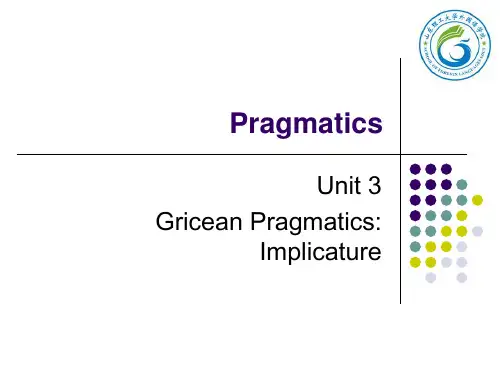
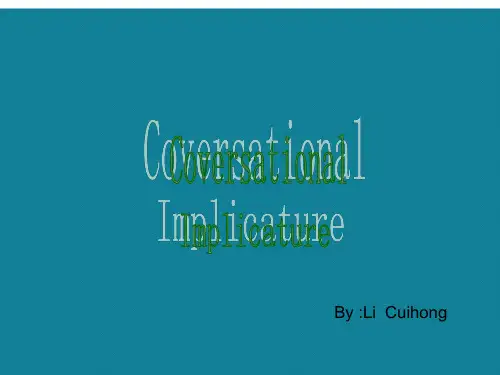
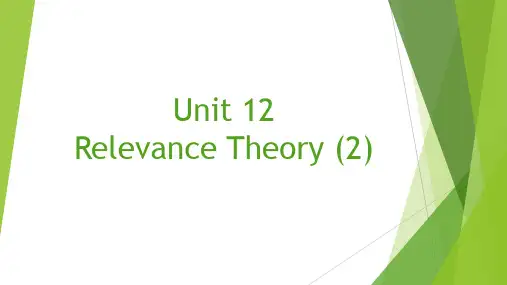

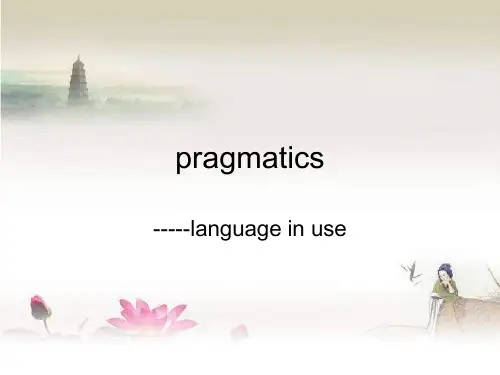
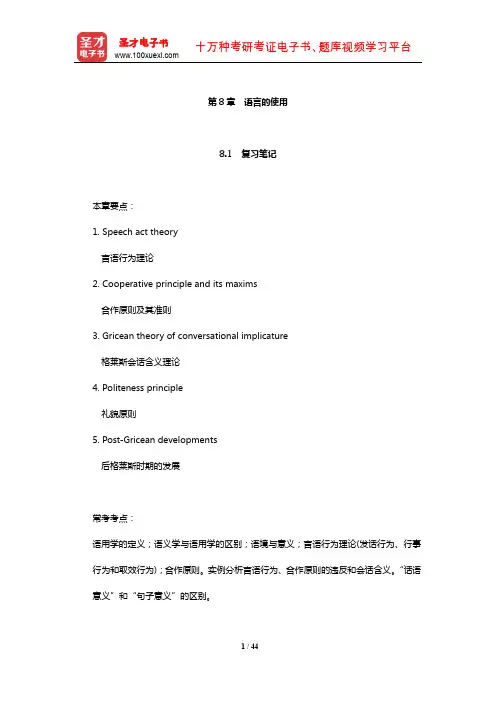
第8章语言的使用8.1 复习笔记本章要点:1. Speech act theory言语行为理论2. Cooperative principle and its maxims合作原则及其准则3. Gricean theory of conversational implicature格莱斯会话含义理论4. Politeness principle礼貌原则5. Post-Gricean developments后格莱斯时期的发展常考考点:语用学的定义;语义学与语用学的区别;语境与意义;言语行为理论(发话行为、行事行为和取效行为);合作原则。
实例分析言语行为、合作原则的违反和会话含义。
“话语意义”和“句子意义”的区别。
本章内容索引:I. Pragmatics1. Definition2. Difference between pragmatics and semantics II. Speech Act Theory1. Performatives and Constatives(1) Definition(2) Felicity Conditions2. A Theory of the Illocutionary Act3. Searle’s Classification of Speech Acts(1) Representatives:(2) Directives(3) Commsives(4) Expressives(5) DeclarationsIII. Cooperative Principle (CP)1. Cooperative Principle and Its Maxims2. Violation of the MaximsIV. Conversational Implicature1. Definition2. Characteristics of Conversational Implicature(1) Calculability.(2) Cancellability(3) Non-detachability(4) Non-conventionality.V. Politeness Principle (PP)VI. Post-Gricean Developments1. Relevance Theory2. The Q- and R-principles3. Levinson’s Q-, I-and M-principles▼4. A socio-cognitive approachI. Pragmatics (语用学)【考点:Pragmatics与Semantics的异同】1. Definition (定义)Pragmatics is the study of language in use, focusing on the study of speaker’s meaning, utterance meaning or contextual meaning.语用学是研究语言实际运用的学科,集中研究说话人意义、话语意义或语境意义。
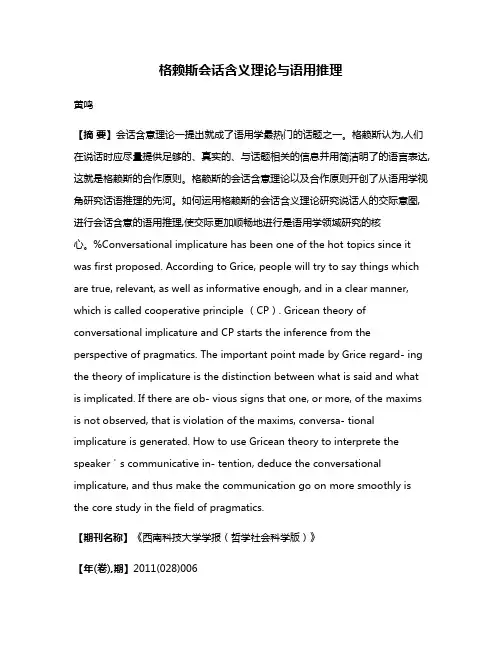
格赖斯会话含义理论与语用推理黄鸣【摘要】会话含意理论一提出就成了语用学最热门的话题之一。
格赖斯认为,人们在说话时应尽量提供足够的、真实的、与话题相关的信息并用简洁明了的语言表达,这就是格赖斯的合作原则。
格赖斯的会话含意理论以及合作原则开创了从语用学视角研究话语推理的先河。
如何运用格赖斯的会话含义理论研究说话人的交际意图,进行会话含意的语用推理,使交际更加顺畅地进行是语用学领域研究的核心。
%Conversational implicature has been one of the hot topics since it was first proposed. According to Grice, people will try to say things which are true, relevant, as well as informative enough, and in a clear manner, which is called cooperative principle (CP). Gricean theory of conversational implicature and CP starts the inference from the perspective of pragmatics. The important point made by Grice regard- ing the theory of implicature is the distinction between what is said and what is implicated. If there are ob- vious signs that one, or more, of the maxims is not observed, that is violation of the maxims, conversa- tional implicature is generated. How to use Gricean theory to interprete the speaker's communicative in- tention, deduce the conversational implicature, and thus make the communication go on more smoothly is the core study in the field of pragmatics.【期刊名称】《西南科技大学学报(哲学社会科学版)》【年(卷),期】2011(028)006【总页数】5页(P31-35)【关键词】会话含意;合作原则;语用推理【作者】黄鸣【作者单位】成都大学外国语学院,四川成都610106【正文语种】中文【中图分类】H030美国哲学家格赖斯(H.P.Grice)在1957年发表的《意义》一文中把意义分为两类:“自然意义”(natural meaning)和“非自然意义”(non-natural meaning)。
